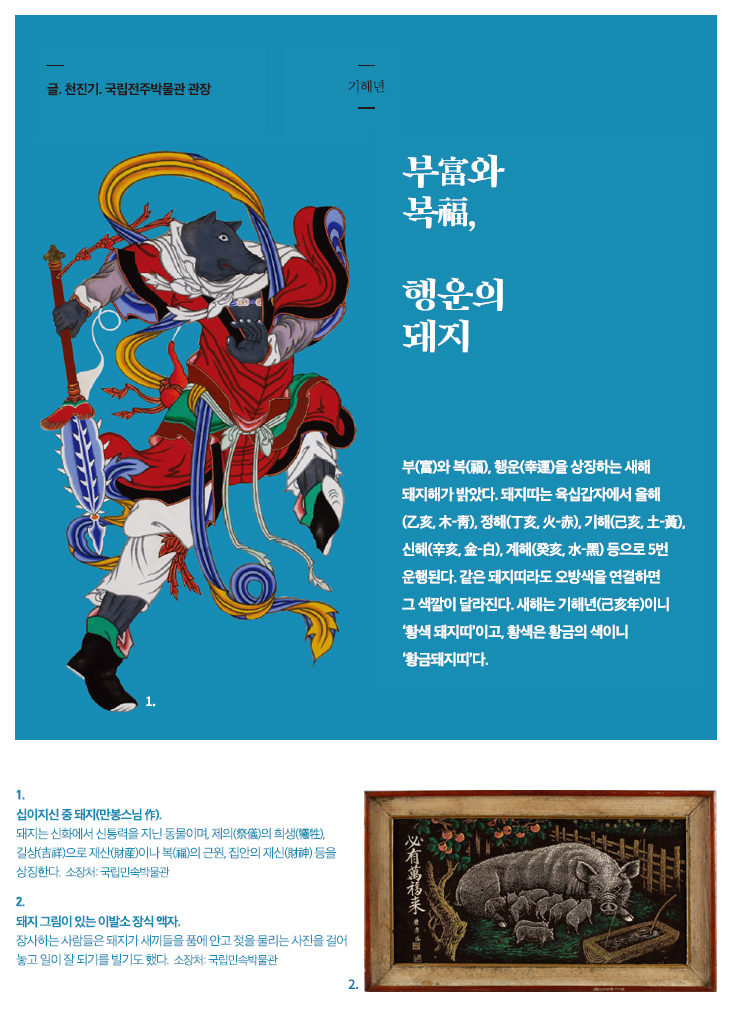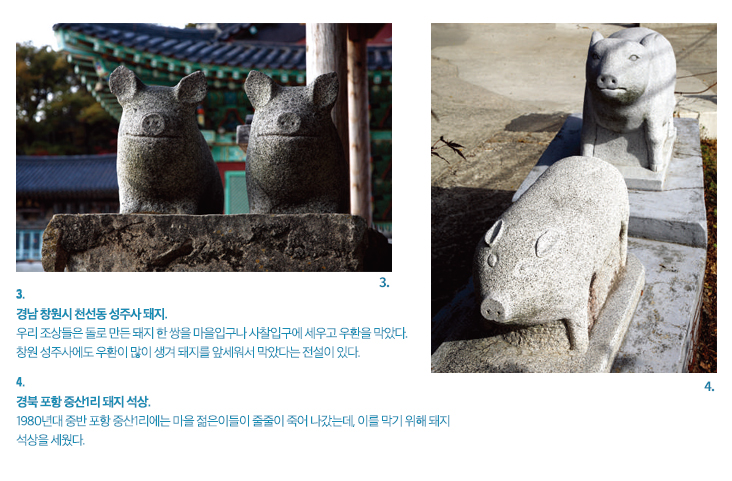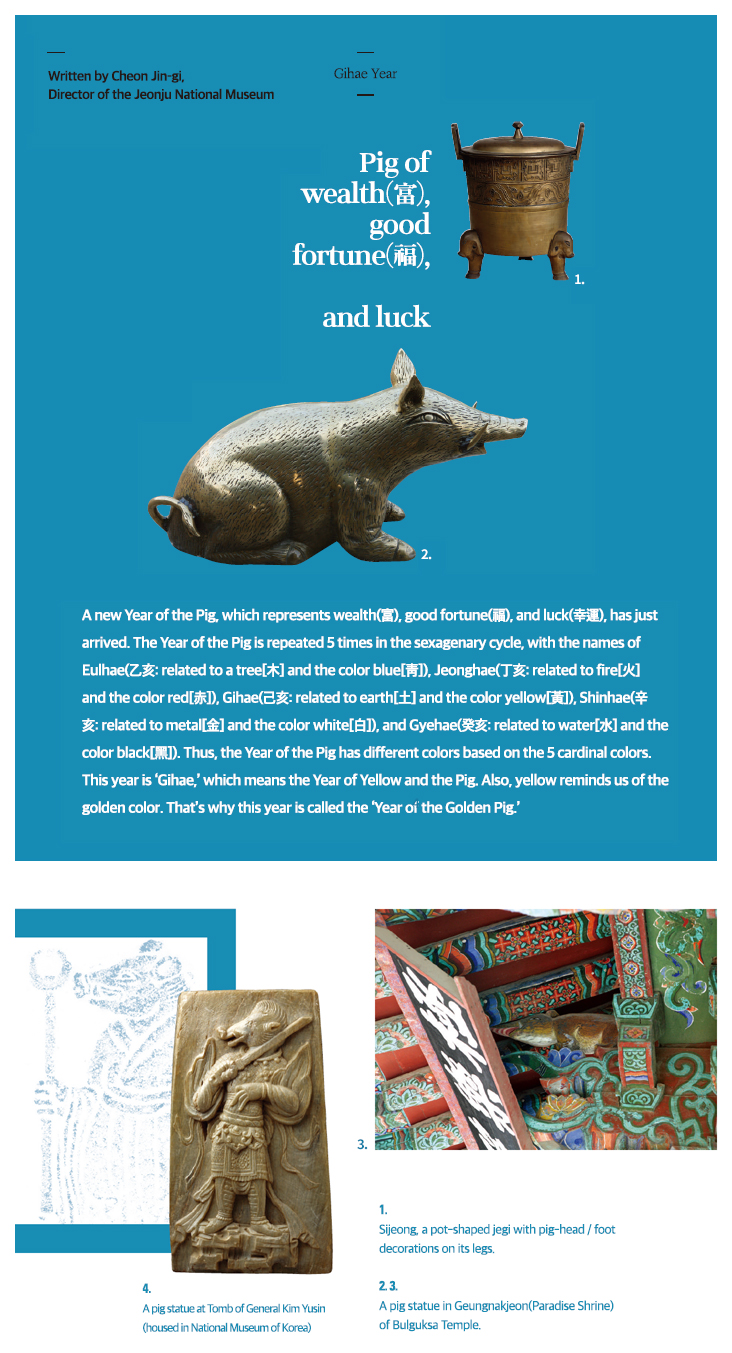참여/소식
월간문화재


저돌(諸突),먹성,야성의 화신,멧돼지
우리나라의 멧돼지는 몽툭한몸뚱이,거친 털,기다란주둥이,조그만 눈,빈약한 꼬리 등이 그 외형이다. 저돌(瘡突)이란 말에서처럼 멧돼지는 성이 나서 날뛰며 덤벼들기라도 하면 그 사나움이란 노한 호랑이와 진배없을 정도다.멧돼지는 ‘먹성’과 ‘야성’의 화신으로 냄새를 맡는 데도 귀신이다. 성깔이 신경질적이고 경계심이 강하며,전광석화처럼 민첩하고 헤엄도 잘 친다. 돼지는 기후•풍토에 대한 적응력이 강해세계적으로 분포돼 있다.
돼지의 오해와 진실
사람들은 보통 돼지를 게으름과 식탐,지저분함의 상징처럼 여긴다.하지만 사실 돼지는 인간에게 ‘복덩이’다. 수많은 동물 중에서도 천성이 순박하고 인간에게 더없이 유익한 동물이 바로 돼지다.££돼지우리처럼 더럽다”라는 선입견은 인간들의 욕심으로 인한오해다. 공간만 충분히 확보해 준다면 돼지는 잠자리와 배변 장소를 가릴 줄 아는 나름 청결함을 유지하는 동물이다. 지능지수(10)도 집을지키는 개와 맞먹는다. 후각이 매우 발달해 값비싼 송로버섯을 찾는똑똑한 돼지도 있다음식을 급하게 먹거나많이 먹을 때£<돼지처럼 먹는다”라고 한다. 돼지는 아무리 배가 불러도 계속 먹을 거라는 편견이 있지만,실제로는 일정한 양만 섭취하고 그 이상은 먹지 않는다. 대부분의 농가는사료를 제한 없이 맘껏 먹을 수 있도록 주지만,돼지는 스스로 적정량만 먹는다. 돼지는 잡식성이어서 사람이 먹다 남긴 음식찌꺼기나쌀뜨물만 먹여도 잘 자란다. 돼지는 보통 한 번에 10마리씩 새끼를낳을뿐만아니라 임신 기간도 114일로비교적 짧다.
언어권마다 달리 들리는 돼지소리
“꿀꿀”(한국) “오잉크 오잉크”(영어권) “부-부”(일본) “헝헝”(중국)“운인”(베트남) “흐류흐류”(러시아) “크노르”(네덜란드) 등 돼지 울음소리는 언어권에 따라 달리 들린다고 한다. 하지만 그 소리가 어떻든 한국문화에서 돼지는 길상(吉神)으로 재산(財産)이나 복(福)의근원,집안의 재물신(財物神)을 상징한다. 그런가 하면 속담에서 돼지는 대부분 탐욕스럽고,더럽피 게으르며 우둔한 동물로 묘사되고있다. 즉 돼지는 상서로움과 탐욕스러움의 서로 반대되는 속성을 갖춘,이른바 모순적 등가성(子唐的 等價性)을 지니고 있는 십이지의열두 번째 띠 동물이다.1억 이상 복권 당첨자 23%… 행운을 가져오는 꿈이 있다면 무엇일까? 만약 돼지를 생각했다면 작년에 거액의 복권에 당첨된 사람들의생각파 비슷하다고 볼 수 있다. 국민은행이 작년 1년 동안 주택복권등을 구입해 1 억 원 이상 대박을 터뜨린 43명을 조사한 결과,이 중 명이 ‘돼지꿈’을 꾼 뒤 행운을 잡은 것으로 나타났다
-사일보,20020216.
우리나라는 예로부터 집집마다 돼지를 길렀고 어쩌다 돼지꿈을꾸면 재수 좋은 꿈을 꾸었다고 기뻐했다. 장사하는 사람들은 돼지가 새끼들을 품에 안고 젖을 물리는 사진을 걸어 놓고 일이 잘 되기를 빌기도 했다. 상점에는 새해 첫 돼지날 상해일에 문을 열면 한 해 동안 장사가 잘 된다는 속신도 있다. 죽어서도 돼지혈(穴)에 묘를 쓰면 부자가 된다고 믿어 왔다. 이처럼 한국 사람들은 예로부터 돼지를 부(富)와 복(福)의 상징으로,돼지꿈을 재운(財運)과행운(幸運)의 상징으로 여겨왔다.
신화적 신통력을 지닌 동물
돼지는 신화에서 신통력을 지닌 동물이며,제의(祭儀)의 희생(儀性),길상 으로 재산(財産)이나 복의 근원 등을 상징한다.한국 신화에 등장하는 돼지는 신에게 바치는 제물임과 동시에,나라의 수도를 정해 주고 왕이 자식이 없을 때 왕자를 낳을 왕비를알려줘 대를 잇게 하는 신통력을 지닌 동물로 전해진다.『삼국사기(三國史記)』의 고구려 유리왕 편과『고려사(高麗史)』의 고려세계(高麗世系)에는 돼지가 고구려의 수도 국내성과 고려의 수도 송악을 점지해 준 기록이 있다.『삼국사기』고구려본기 산상왕(山上王) 편에서 산상왕은 0ᅵ들이 없었으나 돼지의 도움으로 아들을 낳았다는 기록이 있다. 이들은 보통 돼지가 아니라 하늘의 제사에쓰이는 제물의 돼지다. 제물로 쓰인 돼지는 신통력이 있고,신의뜻을 전하는 사자(使者)의 상징으로도 나타난다.
제전際典)의 희생(儀性)
우리는 굿이나 고사 등을 지낼 때 상 위에 돼지머리를 놓은 모습을 흔히 볼 수 있다. 그러면 돼지는 언제부터 제물로 쓰였을까?돼지는 일찍부터 제전에 희생으로 쓰인 동물이다.『삼국사기』고구려본기에는 하늘과 땅에 제사를 지낼 때 쓰는 희생으로 교시(部家)에 관한 기록이 여러 번 나온다.『삼국사기』제사(祭祀) 조에 보면 ‘고기位誠’를 인용해 “고구려는 항상 삼월 삼일에 낙랑의 구릉에 모여 사냥하고 돼지와 사슴을 잡아 하늘과 산천에 제사한다”고 했다. 또한『동국세시기』(東國歲時記) 십이월 납조에는 산돼지가 납향®事)의 제물로 쓰였다는 기록이 있다.오늘날에도 굿이나 동제(洞祭)에는 돼지를 희생으로 쓰고 있다.또한 각종 고사 때는 어김없이 돼지머리가 등장한다. 그래서 시월상달 고사철이면 푸줏간들이 ‘고사용 돼지머리 있음’이라고써 붙이곤 했다. 이처럼 제전에 돼지를 쓰는 풍속은 멀리 고구려 때부터 시작해서 오늘날까지도 전승되고 있는 역사 깊은 민속이다.
땅기운을 다스리는 돼지 한 쌍
돌로 만든 돼지 한 쌍을 마을입구나 사찰입구에 세우고 우환을 막는다. 경북 포항 중산1리 마을회관 앞에는 돌로 만든 작은 돼지와큰 돼지가 일렬로 늘어서 있다. 1980년대 중반에 마을 젊은이들이줄줄이 죽어 갔고,마을 기운도 갈수록 쇠했다. 어느 날 지나가던스님이 ‘동네 터가 뱀혈이라서 뱀이 동네를 해롭게 하고 있으니,뱀이 질색하는 돼지 석상을 세우라!’고 조언했다. 경남 창원불모산 아래 성주사 대웅전 입구에도 돼지 석상 한 쌍이 서 있다.절터의 형상이 제비집(蒸集穴)인데 절 앞산이 제비를노리는 뱀의머리와같기 때문이라는 이야기도 있고,절에 뱀이 많아서 그랬다는이야기도 있다.마을과 절터의 뜨거운 화기를 누르기 위해 돼지 석상을 세운 것이다. 뱀은 불(火)을 의미하고 돼지는 물(水)을 상징한다. 물을 상징하는 돼지務,水)를 통해 터의 뜨거운 화기( 火)를 누른 것이다.실제로 돼지는 살모사가 물어도 끄떡하지 않을 정도로 뱀과 상극인동물이다.금돼지의 자식,신라 말 최고의 문장가 최치원신라 말 최고의 문장가였던 최치원(崔致遠)이 금돼지의 자식이라는 고전소설이 있다. 이 소설은 작자와 연대 미상의『최고운전(崔孤雲傳)』으로,최치원의 일생을 허구적 구성으로 형상화한 전기적 소설이다.
신라 시대 부임하는 신임 현령 부인이 실종되는 문창에 현령으로 부임한 최충은 미리 부인의 손에 명주실을 매어 두었다가 부인이실종되자 찾아 나선다. 실이 뒷산 바•우/틈으로 들어간 것을 확인한 최충은부인을잡고 있던 금돼지를죽이고 부인을구하여 온다. 그 후부인이 아들 최치원을 낳자 최충이 금되?자으/ 자식이라며 버렸더니,선녀가 내려와 보호해 주고 천유가 내려와 글을 가르친다. 치원의글 읽는 소리가 중국의 황제에게까지 들리자 황제가 두 학사를 보내글을 겨루게 하나 치원을 당하지 못했다
돼지의 기운 받은 돼지띠 인물들
한국인들은 자기 띠 동물의 생태와 특징들을 자신의 운명 이나 팔자와 동일시한다. 아마 평생 자기의 수호신인 띠 동물의 덕성과장점을 배우고 닮으려는 마음이 이런 민속을 만들어 냈을 것이다.돼지띠는 성실하고 책임감이 강하다고 한다. 돼지의 해에 태어난인물로는 후백제와 조선을 건국한 견훤•이성계가 대표적이다. 고구려 동명성왕,통일신라 태종무열왕,광해군,명성황후 그리고 이승만 대통령 등도돼지띠다.
길상,복,집안 재물신의 상징
‘돼지 같은 녀석”…. 이렇게 욕을 하면서도 한국인은 돼지꿈을 대단한귀물(貴物)로 여긴다. 상상의 동물인 용(龍)은왕권의 상징이다. 그래서 용꿈은 태몽 중의 으뜸인데,장차 이름을 크게 떨칠 사내아이를 낳게 될 꿈이 바로 용꿈이다. 이에 비해 돼지꿈은 부의상징으로 집 안에 모시고 믿음을 바치던 ‘업신’이 현실의 재물신(財物神)이라면 돼지는 꿈속의 재물이다. 이런 즉,어쩌면 돼지꿈은 용꿈보다 한 수 위인지도 모르겠다. 왜냐하면 돼지꿈은 길조와행운의 상징,그자체이며 다산(多産)까지 겸하고 있기 때문이다.또한 돼지 그림이나 돼지코는 번창의 상징이나 부적으로 이용되는데,이는 돼지가 가계의 기본적인 재원(財源)이었으며 한자의‘돈’이 ‘돈(金)’과 음이 같은 데에 연유한다. 이렇듯 장사하는집에서는 곧잘돼지 그림을 문설주 위에 붙여서 사업의 번창을 기원했다.2019년 기해년 황금돼지띠를 맞아 모든 가정에 풍년과 번창이 함께하기를 두 손 모아 기원한다.

Wild pig: the incarnation of recklessnessappetite, and wild nature
Wild pigs in Korea are characterized by a stubby torso, coarse hair,a long snout, small eyes, and a little tail. As the term ‘(rushlike a pig; recklessness)’ shows, the wild pigs move with the speedof furious tigers when they1 re jumping to a counterattack in rage.Also, wild pigs, as the incarnations of appetite and wild nature,are demons at sniffing out smells. Their temper is impulsive,their sense of wariness is high, and their moves are as quick aslightning. Besides this, they5 re good at swimming. Pigs have greatadaptability to different climates and theyVe spread throughoutthe world.
Misunderstandings and truths about pigs
The pig is usually considered as an icon of laziness, gluttony, anddirtiness. However, a pig actually represents a lot of luck’: the pigis the animal that has a more innocent nature than any others,and couldn’t be more useful to humans.Prejudiced terms such as describing a dirty place as a ‘pigsty’indicate mankind’s misunderstanding of pigs due to our owngreed. If a sufficient space is prepared, pigs will differentiate theirbeds from their bathroom, and will maintain their cleanliness ontheir own. In addition, their IQ^is equivalent to that of dogs, whichguard our households. Some smart pigs also have very developedolfactory sense so that they are used to find expensive truffles.Eating quickly or eating too much is termed eating like a pig.’ Butunlike the prejudiced notion that pigs don’t stop eating no matterhow full they are, they actually will consume a certain amountof food and no more. Most farms give them limitless feed tolet them eat as much as they like, but they only eat an onlyappropriate quantity. Pigs live on a mixed diet, and they grow welleven when they have only food scraps from men or the waterused to wash rice. Pigs usually give birth to 10 babies at a time,and they also have a relatively short pregnancy period of 114 days.
Different pig sounds by language
“Kkul kkid” (Korea) “Oink oink” (English speaking countries)“Bu-bu” (Japan) “Hung hung” (China) “Woonin” (Vietnam), “Xrjuxrju” (Russia) “Knor” (Ne仕lerlands) … As can be seen from theseexamples, the pig’s grunting is heard differently in differentlanguages. However, no matter how it sounds, the pig is treatedas a lucky omen in Korean traditional culture, representingthe roots of fortune and the god of wealth in a household.Meanwhile, in most proverbs, the pig is described as a greedy,dirty, lazy, and stupid animal. In other words, the pig, the 12th ofthe twelve Chinese zodiac animals, has a contradictory naturethat is equivalent to its conflicting characteristics: it’s both luckyand greedy.Many Korean people raised pigs as livestock from olden times,and they loved dreaming of pigs, as this was considered as asign of luck. Merchants put a picture of a mother pig feedingits piglets on their walls in hopes that it would bring success totheir business. According to a common saying, a shop will have agreater profit in the coming year, if it opens on the first Day of thePig in that year (Sanghaeil[上※ 日 ]). Furthermore, there is a beliefthat placing a grave on a propitious site related to the pig willbring wealth to one’s descendants.
The animal with a mythical supernatural power
In myths, the pig is an animal with supernatural power,representing sacrifice in rituals, signs of luck as the roots offortune/luck, and a god of fortune in the household. Koreanmyths treat the pig as a sacrificial offering to the gods, and alsoas an animal with superpowers that can choose the location of anation’s capital and a queen to carry the family line for a childlessking. Several chapters of the historical literature (such as theGoguryeo King Yuri chapter in the history ‘Samguk sagi [nd the ‘Goryeosegye[iSStS],chapter in the Goryeosa[iShave episodes in which pigs are used to choose theGungnae Fortress (capital of Goguryeo) and Songak (capitalof Goryeo). Also, the Samguk sagi’s chapter on the GoguryeoKing Sansang records that the king had no sons, but was latersuccessful in having one with the help of a pig.These pigs in myth are not ordinary; they5 re sacrificial offeringsused in rites directed towards celestial spirits. The offerings aretreated as something supernatural, and also as the icon of anangel that can deliver the god’s will.
Sacrifices in festivals
It’s a common scene in Korea for a pig’s head to be served at thetable during shamanistic rituals/exorcisms. But when did thistradition begin?Pigs have been used as sacrifices since the earliest times inKorean history. The Samguk saki’s chapter on the Goguryeobongi includes several records of ‘Gyosi (交which meanspigs that are preserved for rites directed towards the heavens andearth. The Jesa(^)jiE- rite) chapter of the Samguk sagi cites thehistorical literature of the ‘Gogi(占|己)’,which says that “Goguryeoalways has a gathering at a hill in Nakrang on every 3rd day ofthe 3rd month to hunt for pigs and deers, and then performs ritesdirected towards the heavens and nature.” In addition, anotherliterary history, the ‘DongguksesigiC國!0寺己),’ has a recordstating that wild hogs were used as offerings for the Naphyang(a rite to inform the heavens about the results of farming andother news of the year), in a chapter on the rite held in the 12thmon仕i(十三H ).Today, pigs are still used for shamanistic exorcisms or Dongje(?同총: a town’s rite towards the totems of the town to wish for botha rich harvest and exemption from diseases or disasters). Also,pig’s heads appear at the table in all kinds of Gosa rites. Thus,preparing a pig’s head in these rites is a very historical ethnictradition that has been passed down since the Goguryeo Era tothis day.
A couple of pigs that control the energy of the earth
A couple of stone pigs often stand at the entrance of a town/temple to prevent misfortune. Similarly, small/big pigs madeof stone were placed in a line in front of the village hall at theentrance of Joongsan 1-ri, Pohang, Gyeongsanbuk-do. In the mid-1980s, a number of young persons suddenly died one after theother in this town, and development of the town declined astime went by. Then, a Buddhist monk visited the town, and gavethe residents some advice: (
Choi Chi-won: the best writer in the late Silla Era,and the son of a Golden Pig
There is a Classical novel that states Choi Chi-won ®SM), thebest writer in the late Silla Age, was the son of a Golden Pig. Itstitle is 'Choigounjeon®HUSff)? with an unidentifiable authorand era, and is a novel that offers a fictional biography of thewriter.
“In a region named Moonchang in the Silla Age, every governorhad an experience where their wives went missing as soon asthey start their terms in office. Choi Choong came there as anew governor, and he tied a silk thread to his wife’s hands beforesleeping. When she disappeared, he followed the thread and wentinto the rocks on a mountain behind the town. There, he foundher caught by a golden pig, and he killed the pig to save her.Afterwards, she gave birth to their son Choi Chi-won, but ChoiChoong abandoned the baby for the reason that the baby wasthe son of the golden pig. A Taoist fairy then came down fromheaven to protect him, and some angels followed and taught himto write. The sound of his reading spread to even the Emperor ofChina, and two scholars were sent by the Emperor to compete inwriting with him. But they couldn’t beat Choi Chi-won.
Figures born in the Year of the Pig are bornwith the spirit of the pig
Korean people often regard their own fate or destiny in thesame light as the characteristics of the Chinese zodiac animalthat corresponds to the year when they were bom. This custompossibly arose from the mentality that they want to resemble andkam from the virtues and strengths of these animals, which areconsidered as the guardians for one’s entire lifetime. There’s asaying about people bom in the Year of the Pig, which states thatthey are sincere and fully responsible. Gyeon-whon (the founderof Post Baekje) and Yi Seong-gye (the founder of Joseon) arerepresentative historical figures who were bom in the Year of thePig. Additionally, Goguyeo’s King Dongmyeongseong, UnifiedSilla,s King Taejongmooyeol, Joseon,s King Gwanghae, QueenMyeongseong (wife of King Gojong), and the former President YiSeung-man all have same Chinese zodiac animal.
Icon of luck, fortune, and the godof fortune in a household
While Korean people often use the expression “you’re like a pig”in a critical way, they consider dreaming of a pig as somethingvery precious. The dragon, an imaginary animal, is an icon ofroyal authority. That is why dreaming of a dragon is regarded asthe best Taemong明合 precognitive dream about the birth of achild), because the dragon is interpreted as being a sign that thebaby will be a successful figure. On the other hand, dreamingof pig represents wealth. While the ‘Eopshin’ enshrined andworshiped in households is the god of wealth in reality, the pigis the representative of wealth in dreams. You could even saythat encountering a pig in a dream may be better than a dragon,because it offers predictions of luck as well as fecundity.










